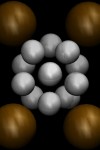A new class of compounds which contain very large amounts of hydrogen, stored in tiny clusters of 13 molecules, has been discovered by CSEC researchers in collaboration with colleagues from the Chinese Academy of Sciences.
These clusters, known as “supermolecules” are as icosahedral balls with one central hydrogen surrounded by 12 others. The supermolecules are then packed together with other molecules to give compounds with an exceptionally high hydrogen content. In the iodane–superhydrogen compound there are 27 hydrogens for every iodine atom.
Their discovery opens the possibility of storing hydrogen in a molecular form within a chemical compound. Hydrogen storage is essential for fuel cells, but in most compounds the hydrogen is chemically bonded to another element, requiring energy to extract it before it can be used.
The Iodane-hydride compound was made by a team of researchers at the Centre for Science at Extreme Conditions in the University of Edinburgh, collaborating with former colleagues now working in Shanghai. The fundamental properties of various materials were predicted using the ARCHER supercomputer at the University of Edinburgh, by calculations involving advanced quantum mechanics. The Iodane compound was synthesized under high pressure in the laboratory in China. On releasing the pressure, it rapidly decomposed releasing the hydrogen molecules, but was shown to be quickly reformed by repressurization. Related materials may release their hydrogen when heated.
The structure itself has unusual icosahedral (fivefold) symmetry. It is not possible to fill space with a repeating fivefold pattern, so alternate supermolecules have to be twisted to accommodate one another.
